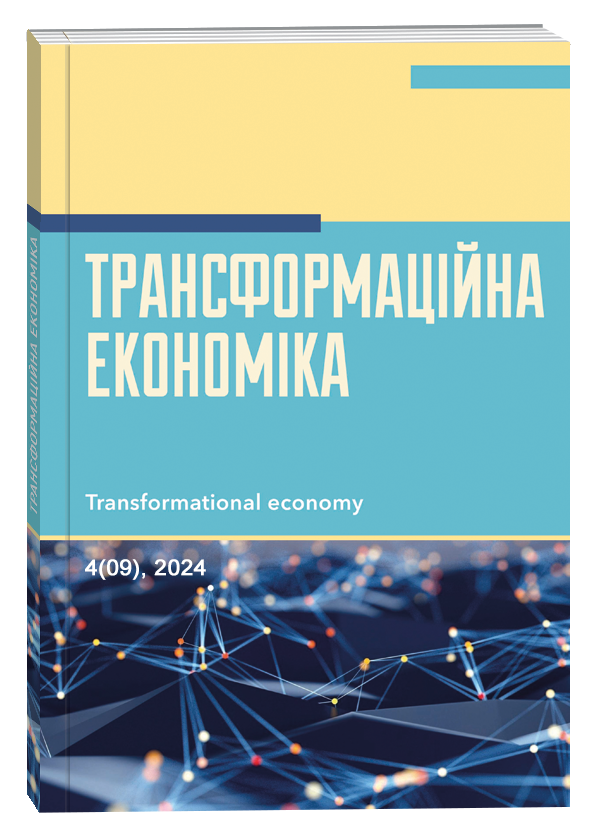PUBLIC DEBT OF UKRAINE 2024: CURRENT STATE AND IMPACT ON THE COUNTRY’S ECONOMY
Abstract
Public debt is an important component of a market economy. Today it is difficult to find a state that would be able to do without borrowing. The state's use of loans is due to the lack of its own financial resources, which are necessary for financing the state budget. Under the condition of effective use, the funds raised can become a positive factor in economic growth, but otherwise, the increase in indebtedness leads to a financial crisis and a violation of macroeconomic stability. During the period of martial law in Ukraine, the issues of forming and servicing the public debt become particularly relevant, as the country is forced to allocate a significant portion of budget funds to defense needs. According to the current legislation of Ukraine, the state debt is defined as the total amount of the state's debt obligations for the return of received and outstanding credits (loans) as of the reporting date, arising as a result of state borrowing. That is, the state debt is an absolute and unconditional obligation of the state, and the state bears full responsibility for fulfilling the conditions of issuing state debt securities or concluded credit agreements. The public debt arises due to the lack of funds necessary for the state to perform its functions, including regulation of the economy, implementation of social policy, ensuring the country's defense capability, maintenance of the penitentiary system, and international activities. Therefore, the state is forced to mobilize additional financial resources to cover its expenses, which are necessary to ensure its activities and perform its functions. The purpose of the study is to analyze the current size and diagnosis of the features of the formation of Ukraine's public debt, as well as develop recommendations on the mechanism for repaying public debt and reducing its impact on current economic growth. The main reasons for the emergence and growth of public debt in Ukraine are the deficit of the state budget and the permanent deficit of the country's balance of payments, because state borrowing is carried out in order to cover the same budget deficit at the state and regional levels. It is noted that the amount of the total state debt as of September 30, 2024 is 6,404,002.0 million hryvnias, of which the amount of foreign debt is 4,612,991.3 million hryvnias, the amount of domestic debt is 1,791,010.7 million UAH. Therefore, in 2024, Ukraine will have an excessive debt burden mainly due to foreign borrowing, a critical indicator of debt relative to GDP and a tendency towards the growth of external debt, a decrease in its servicing capabilities, which indicates the urgent need to take measures to improve debt policy, minimize debt and strengthen the economy of Ukraine. The government should create an effective debt management system that would ensure financial stability. The development of a medium-term debt strategy, the use of borrowing for development purposes, diagnosis of the debt structure, orientation to the domestic market and stimulation of business activity, etc., are important measures for improving the debt policy.
References
Бюджетний кодекс України. URL: http://surl.li/agrwl
Мінфін. URL: https://index.minfin.com.ua/ua/finance/debtgov/
Горська С.М. Журавель В.С. Державний борг. Його структура та динаміка. URL: http://surl.li/shojl
Reinhart C., Rogoff K. Growth in time of debt. American Economic Review Papers and Proceedings. 2010.
Public debt of the United States from February 2013 to February 2024. URL: https://www.statista.com/statistics/273294/public-debt-of-the-united-states-by-month/
Інформаційна довідка щодо державного та гарантованого державою боргу України. URL: https://www.minfin.gov.ua/news/borhovastatystyka/derzhavnyi-borh-ta-harantovanyiderzhavoiu-borh
Сальникова Т.В. Державний борг України: оцінка та напрями підвищення ефективності управління. Економічний вісник університету. 2017. № 33 (1). С. 385–394.
Список країн за державним боргом. Станом на 2017 рік за даними ЦРУ. URL: https://merkator.org.ua/dovidnyk/spysok-krajin-za-derzhavnymborhom/
Подаков Є.С. Державний борг України та його вплив на економіку країни. Збірник тез ІІІ Всеукраїнської науково-практичної конференції «Публічне управління та адміністрування у процесах економічних реформ». Херсон, 2019. С. 122-124.
Budget Code of Ukraine. Available at: http://surl.li/agrwl
Ministry of Finance. Available at: https://index.minfin.com.ua/ua/finance/debtgov/.
Horska S. M., Zhuravel V. S. State Debt: Its Structure and Dynamics. Available at: http://surl.li/shojl
Reinhart, C., Rogoff, K. (2010) Growth in time of debt. American Economic Review Papers and Proceedings.
Public Debt of the United States from February 2013 to February 2024. Available at: https://www.statista.com/statistics/273294/public-debt-of-the-united-states-by-month/
Informatsiina dovidka shchodo derzhavnoho ta harantovanoho derzhavoiu borhu Ukrainy [Information note on state and state-guaranteed debt of Ukraine]. Available at: https://www.minfin.gov.ua/news/borhova-statystyka/derzhavnyi-borh-taharantovanyi-derzhavoiu-borh
Sal'nikova T. V. (2017) State debt of Ukraine: assessment and directions for improving management efficiency. Economic Bulletin of the University. vol. 33 (1). рp. 385–394.
Spysok krain za derzhavnym borhom. Stanom na 2017 rik za danymy TsRU [List of countries on public debt, according to the CIO]. Available at: merkator.org.ua/dovidnyk/spysok-krajin-za-derzhavnym-borhom/
Podakov Ye. S. (2019) The national debt of Ukraine and its impact on the country's economy. Collection of theses of the 3rd All-Ukrainian Scientific and Practical Conference "Public Management and Administration in the Processes of Economic Reforms". Kherson. P. 122-124.


